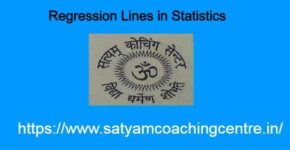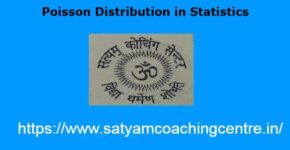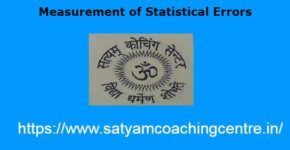Coefficient of Variation in Statistics
1.सांख्यिकी में विचरण-गुणांक (Coefficient of Variation in Statistics),हिन्दी में विचरण गुणांक (Coefficient of Variation in hindi):
सांख्यिकी में विचरण-गुणांक (Coefficient of Variation in Statistics) एक सापेक्ष माप (relative measures) है।इसका प्रतिपादन कार्ल पियर्सन (Karl Pearson) ने 1895 में किया था।अतः इसे कार्ल पियर्सन का विचरण गुणांक (Karl Pearson’s Coefficient of Variation) भी कहते हैं।कार्ल पियर्सन के अनुसार, “विचरण-गुणांक माध्य में होने वाला प्रतिशत विचरण है जबकि प्रमाप विचलन को माध्य में होने वाला सम्पूर्ण विचरण माना जाता है।” इसका प्रयोग दो समूहों की अस्थिरता (Variability),सजातीयता (Homogeneity),स्थिरता (Stability) तथा संगति (Consistency) की तुलना के लिए किया जाता है। जिस श्रेणी में विचरण गुणांक कम होता है वह श्रेणी उस श्रेणी से अधिक स्थिर (संगत) होती है जिसमें विचरण गुणांक अधिक होता है।
विचरण गुणांक(Coefficient of Variation)=\bar{X}=\frac{\sigma}{\bar{X}} \times 100
आपको यह जानकारी रोचक व ज्ञानवर्धक लगे तो अपने मित्रों के साथ इस गणित के आर्टिकल को शेयर करें।यदि आप इस वेबसाइट पर पहली बार आए हैं तो वेबसाइट को फॉलो करें और ईमेल सब्सक्रिप्शन को भी फॉलो करें।जिससे नए आर्टिकल का नोटिफिकेशन आपको मिल सके । यदि आर्टिकल पसन्द आए तो अपने मित्रों के साथ शेयर और लाईक करें जिससे वे भी लाभ उठाए । आपकी कोई समस्या हो या कोई सुझाव देना चाहते हैं तो कमेंट करके बताएं।इस आर्टिकल को पूरा पढ़ें।
Also Read This Article:-Combined Standard Deviation
2.सांख्यिकी में विचरण-गुणांक के साधित उदाहरण (Coefficient of Variation in Statistics Solved Examples):
Example:1.X तथा Y अंशों के मूल्य निम्नवत् हैं। इनके आधार पर यह बतलाइए कि कौन-से अंश के मूल्य में अधिक स्थिरता है:
(From the prices of shares X and Y given below, State which share is more stable in value):
| Month | Share X | Share Y |
| Jan | 55 | 108 |
| Feb | 54 | 107 |
| March | 52 | 105 |
| April | 53 | 105 |
| May | 56 | 106 |
| June | 58 | 107 |
| July | 52 | 104 |
| Aug | 50 | 103 |
| Sept | 51 | 104 |
| Oct | 49 | 101 |
Solution:Calculation of Coefficient of Variation
| Month | Share X | Deviation(d) \bar{X}=53 |
d^{2} | Share Y | Deviation(d) \bar{X}=105 |
d^{2} |
| Jan | 55 | 2 | 4 | 108 | 3 | 9 |
| Feb | 54 | 1 | 1 | 107 | 2 | 4 |
| March | 52 | -1 | 1 | 105 | 0 | 0 |
| April | 53 | 0 | 0 | 105 | 0 | 0 |
| May | 56 | 3 | 9 | 106 | 1 | 1 |
| June | 58 | 5 | 25 | 107 | 2 | 4 |
| July | 52 | -1 | 1 | 104 | -1 | 1 |
| Aug | 50 | -3 | 9 | 103 | -2 | 4 |
| Sept | 51 | -2 | 4 | 104 | -1 | 1 |
| Oct | 49 | -4 | 16 | 101 | -4 | 16 |
| Total | 530 | 70 | 1050 | 40 |
Share X
\bar{X}=\frac{\Sigma X}{N}=\frac{530}{10}=53\\ \sigma = \sqrt{\frac{\Sigma d^{2}}{N}}\\ =\sqrt{\frac{70}{10}}\\ =\sqrt{7}\\ \sigma=2.6457\\ \sigma \approx 2.65 \\ \text{C.V.} =\frac{\sigma}{\bar{x}} \times 100\\ =\frac{2.65}{53} \times 100 \Rightarrow \text{C.V.} =5 \%Share Y
\bar{Y} =\frac{\Sigma Y}{N} \\ =\frac{1050}{10} \\ \Rightarrow \bar{Y} =105 \\ \sigma =\sqrt{\frac{\Sigma d^{2}}{N}} \\ =\sqrt{\frac{40}{10}} \\ =\sqrt{4} \\ \Rightarrow \sigma =2 \\ \text{C.V.}=\frac{\sigma}{\bar{Y}} \times 100 \\ =\frac{2}{105} \times 100 \\ =\frac{200}{105} \\ =1.9047 \% \\ \text{C.V.}=1.905 \%
Y is more stable in value
Example:2.A और B बल्लेबाजों द्वारा विभिन्न पारियों में बनाये गये रनों की संख्या निम्नवत् है,बतलाइए कि कौन-सा बल्लेबाज अधिक अच्छा है:
(The runs made by 2 batsmen A and B in different innings are given below, State which batsman is better):
| A | B |
| 12 | 47 |
| 115 | 12 |
| 6 | 76 |
| 73 | 42 |
| 7 | 4 |
| 19 | 51 |
| 119 | 37 |
| 36 | 48 |
| 84 | 13 |
| 29 | 0 |
Solution:Calculation of Coefficient of Variation
| Runs made by A | Deviation(d) \bar{X}=50 |
d^{2} | Runs made by B | Deviation(d) \bar{X}=33 |
d^{2} |
| 12 | -38 | 1444 | 47 | 14 | 196 |
| 115 | 65 | 4225 | 12 | -21 | 441 |
| 6 | -44 | 1936 | 76 | 43 | 1849 |
| 73 | 23 | 529 | 42 | 9 | 81 |
| 7 | -43 | 1849 | 4 | -29 | 841 |
| 19 | -31 | 961 | 51 | 18 | 324 |
| 119 | 69 | 4761 | 37 | 4 | 16 |
| 36 | -14 | 196 | 48 | 15 | 225 |
| 84 | 34 | 1156 | 13 | -20 | 400 |
| 29 | -21 | 441 | 0 | -33 | 1089 |
| Total=500 | 17498 | 330 | 5462 |
Batsman A
\bar{X} =\frac{\Sigma X}{N} \\ =\frac{500}{10} \\ \Rightarrow \bar{X} =50 \\ \sigma =\sqrt{\frac{\Sigma d^{2}}{N}} \\=\sqrt{\frac{17498}{10}} \\ =\sqrt{1749.8} \\ =41.8306 \\ \sigma \approx 41.831 \\ \text { C.V.}=\frac{\sigma}{\bar{X}} \times 100 \\ \text { C.V.}=\frac{41.831}{50} \times 100=\\ =83.662 \%Batsman B
\bar{Y}=\frac{\Sigma Y}{N}=\frac{330}{10}=33\\ \sigma=\sqrt{\frac{\Sigma d^{2}}{N}}\\ =\sqrt{\frac{5462}{10}}\\ =\sqrt{546.2}\\ =23.3709\\ \sigma \approx 23.371\\ \text{C.V.}=\frac{\sigma}{\bar{X}} \times 100\\ =\frac{23.37}{33} \times 100 =70.821 \\ \text{C.V.} \approx 70.82 \%
B batsman is better of two
Example:3.निम्न समंकों से विचरणता की तुलना कीजिए :
(Compare the variability from the following data):
| Year | Ajmer | Jaipur |
| 1911 | 160 | 228 |
| 1921 | 175 | 213 |
| 1931 | 172 | 173 |
| 1941 | 172 | 204 |
| 1951 | 157 | 198 |
| 1961 | 184 | 205 |
| 1971 | 261 | 263 |
Solution:Calculation of Coefficient of Variation
| Year | Ajmer(X) | deviations(dx) | d^{2} x | Jaipur | Deviations(dy) | d^{2} y |
| from A=172 | from A=204 | |||||
| 1911 | 160 | -12 | 144 | 228 | 24 | 576 |
| 1921 | 175 | 3 | 9 | 213 | 9 | 81 |
| 1931 | 172 | 0 | 0 | 173 | 9 | 81 |
| 1941 | 172 | 0 | 0 | 204 | 0 | 0 |
| 1951 | 157 | -15 | 225 | 198 | -6 | 36 |
| 1961 | 184 | 12 | 144 | 205 | 1 | 1 |
| 1971 | 261 | 89 | 7921 | 263 | 59 | 3481 |
| 1281 | 77 | 8443 | 1524 | 96 | 4256 |
\bar{X}=\frac{\Sigma X}{N}\\ =\frac{1281}{7}\\ \Rightarrow \bar{X}=183\\ \sigma_{x}= \sqrt{\frac{\Sigma d^{2} x}{N}-\left(\frac{\Sigma d x}{N}\right)^{2}}\\ =\sqrt{\frac{8443}{7}-\left(\frac{77}{7}\right)^{2}}\\ =\sqrt{1206.142857-\frac{5929}{49}} \\ =\sqrt{1206.142857-121} \\ =\sqrt{1085.142857} \\ =35.9415066\\ \Rightarrow \sigma \approx 32.94\\ \text{C.V.}=\frac{\sigma_{x}}{\bar{X}} \times 100\\ =\frac{32.94}{183} \times 100=18 \% \\ \bar{Y}=\frac{\Sigma Y}{N}=\frac{1524}{7} \\ \Rightarrow \bar{Y} =217.71\\ \sigma_{y}=\sqrt{\frac{\Sigma d^{2} y}{N}-\left(\frac{\Sigma d y}{N}\right)^{2}}\\ =\sqrt{\frac{4256}{7} -\left(\frac{96}{7}\right)^{2}}\\ =\sqrt{608-\frac{9216}{49}}\\=\sqrt{608-188.08116327} \\= \sqrt{419.9188837}\\ \sigma_{y} \approx 20.49 \\ \text {C.V.} =\frac{\sigma_{y}}{\bar{Y}} \times 100 \\ =\frac{20.49}{217.71} \times 100 \\ =9.4116 \\ \Rightarrow \text {C.V.} \approx 9.41 \%
Ajmer is more variable
Example:4.निम्न दो श्रेणियों से प्रमाप विचलन ज्ञात कीजिए।किस श्रेणी में विचरणता अधिक है, बताइए:
(From the following two series,calculate standard deviation and state which series has greater variation):
| Series A | Series B |
| 192 | 83 |
| 288 | 93 |
| 236 | 93 |
| 228 | 109 |
| 184 | 124 |
| 260 | 126 |
| 284 | 126 |
| 291 | 101 |
| 330 | 102 |
| 243 | 108 |
Solution:Calculation of Coefficient of Variation
| Series A | Deviation(dx) | d^{2} x | Series B | Deviation(dy) | d^{2} y |
| from A=260 | from A=109 | ||||
| 192 | -68 | 4624 | 83 | -26 | 676 |
| 288 | 28 | 784 | 93 | -16 | 256 |
| 236 | -24 | 576 | 93 | -16 | 256 |
| 228 | -32 | 1024 | 109 | 0 | 0 |
| 184 | -76 | 5776 | 124 | 15 | 225 |
| 260 | 0 | 0 | 126 | 17 | 289 |
| 284 | 124 | 15376 | 126 | 17 | 289 |
| 291 | 31 | 961 | 101 | -8 | 64 |
| 330 | 70 | 4900 | 102 | -7 | 49 |
| 243 | -17 | 289 | 108 | -1 | 1 |
| 2636 | 36 | 34310 | 1065 | -25 | 2105 |
Series A
\bar{X}=\frac{\Sigma X}{N}=\frac{2636}{10}\\ \Rightarrow \bar{X}=263.6 \\ \sigma_{x}= \sqrt{\frac{\Sigma d^{2} x}{N}-\left(\frac{\Sigma d x}{N}\right)^{2}}\\=\sqrt{\frac{34310}{10}-\left(\frac{36}{10}\right)^{2}}\\ =\sqrt{3431-12.96}\\ =\sqrt{3418.04}\\ =58.464\\ \sigma_{x} \approx 58.5\\ \text{C.V.}= \frac{\sigma_{x}}{\bar{X}} \times 100 \\ =\frac{58.5 \times 100}{263.6} \\ \text{C.V.}=2.19 \%Series B
\bar{Y}=\frac{\Sigma Y}{N}=\frac{1065}{10}\\ \Rightarrow \bar{Y}=106.5\\ \sigma_{y}= \sqrt{\frac{\Sigma d^{2} y}{N}-\left(\frac{\Sigma d y}{N}\right)^{2}}\\ =\sqrt{\frac{2105}{10}-\left(\frac{-25}{10}\right)^{2}}\\ =\sqrt{210.5-\frac{625}{100}}\\ =\sqrt{210.5-6.25}\\ =\sqrt{204.25}\\ \Rightarrow \sigma_{y} \approx 14.29\\ \text{C.V.} =\frac{\sigma_{y}}{\bar{Y}} \times 100 \\ =\frac{14.29}{106.5} \times 100 \\ =13.417 \approx 13.42 \%A is more variable
Example:5.एक फैक्ट्री के उत्पादन में से 5 इकाइयों का एक प्रतिदर्श लिया गया।उनकी लम्बाई तथा भार निम्नवत् था:
(A sample of 5 items was taken from the output of a factory the length and weight of which as follows):
| Lengths(inches) | Weight(ozs) |
| 3 | 9 |
| 4 | 11 |
| 6 | 14 |
| 7 | 15 |
| 10 | 16 |
इन दो विशेषताओं के विचरण गुणांक की तुलना करके बताइए कि किसमें विचरणता अधिक है?
(By comparing the coefficient of variation of two characteristics state which one is more variable):
Solution:Calculation of Coefficient of Variation
| Lengths(inches) | Deviation(d) from \bar{X}=6 |
d^{2} | Weight(ozs) | Deviation(d) from \bar{Y}=13 |
d^{2} |
| (X) | Y | ||||
| 3 | -3 | 9 | 9 | -4 | 16 |
| 4 | -2 | 4 | 11 | -2 | 4 |
| 6 | 0 | 0 | 14 | 1 | 1 |
| 7 | 1 | 1 | 15 | 2 | 4 |
| 10 | 4 | 16 | 16 | 3 | 9 |
| 30 | 30 | 65 | 34 |
Lengths:
\bar{X}=\frac{\Sigma X}{N}\\ =\frac{30}{5}\\ \Rightarrow \bar{X}=6\\ \sigma_{x}=\sqrt{\frac{\Sigma d^{2}}{N}}\\ =\sqrt{\frac{30}{5}}\\ =\sqrt{6}\\ \sigma_{x}=2.4494\\ \sigma_{x} \approx 2.45\\ \text{C.V.} =\frac{\sigma_{x}}{\bar{X}} \\ =\frac{2.45 \times 100}{6}\\ \Rightarrow \text{C.V.}=40.83 \%Weight
\bar{Y}=\frac{\Sigma Y}{N}\\ =\frac{65}{5}\\ \Rightarrow \bar{Y}=13 \\ \sigma_{y}=\sqrt{\frac{\Sigma d^{2}}{N}} \\ =\sqrt{\frac{34}{5}}\\ =\sqrt{6.8}\\ =2.6076\\ \Rightarrow \sigma_{y} \approx 2.61\\ \text{C.V.}=\frac{\sigma_{y}}{\bar{Y}} \times 100\\ =\frac{2.61}{13} \times 100=20.076\\ \Rightarrow \text{C.V.} \approx 20.08 \%Length is more variable
उपर्युक्त उदाहरणों के द्वारा सांख्यिकी में विचरण-गुणांक (Coefficient of Variation in Statistics),हिन्दी में विचरण गुणांक (Coefficient of Variation in hindi) को समझ सकते हैं।
3.सांख्यिकी में विचरण-गुणांक पर आधारित सवाल (Questions Based on Coefficient of Variation in Statistics):
(1.)निम्नलिखित श्रेणियों द्वारा प्रमाप विचलन गुणांक निकालिए और उसके आधार पर टिप्पणी कीजिए कि इन श्रेणियों में किसमें अधिक विचरण है:
(From the following data find the coefficient of standard deviation and on that basis state which of the two series is more variable):
| Series A | Series B |
| 195 | 80 |
| 280 | 88 |
| 238 | 95 |
| 239 | 110 |
| 185 | 125 |
| 265 | 128 |
| 340 | 125 |
| 290 | 100 |
| 235 | 105 |
| 250 | 108 |
(2.)दो विद्यार्थियों जिन्होंने समान विषय लिया था, निम्नलिखित अंक प्राप्त करते हैं।ज्ञात कीजिए कि उनमें कौन अधिक संगत है?
(Two students offering the same course obtain following marks.Find who is more consistent):
| A | B |
| 58 | 56 |
| 59 | 87 |
| 60 | 89 |
| 65 | 46 |
| 66 | 93 |
| 52 | 65 |
| 75 | 44 |
| 31 | 54 |
| 46 | 78 |
| 48 | 68 |
उत्तर (Answers):(1.) C. of \sigma A=171,B=45 A is more variable
(2.)C.V. of A=29.9%,B=25.2% B is more consistent
उपर्युक्त सवालों को हल करने पर सांख्यिकी में विचरण-गुणांक (Coefficient of Variation in Statistics),हिन्दी में विचरण गुणांक (Coefficient of Variation in hindi) को ठीक से समझ सकते हैं।
Also Read This Article:-Standard Deviation by Short-cut Method
4.सांख्यिकी में विचरण-गुणांक (Coefficient of Variation in Statistics),हिन्दी में विचरण गुणांक (Coefficient of Variation in hindi) के सम्बन्ध में अक्सर पूछे जाने वाले प्रश्न:
प्रश्न:1.अपकिरण की निरपेक्ष और सापेक्ष माप में क्या अन्तर है? (What is the difference between absolute and relative measures of dispersion?):
उत्तर:निरपेक्ष माप (Absolute Measure):
यह माप अपकिरण की मात्रा को बतलाता है और उसी इकाई में व्यक्त किया जाता है जिसमें मूल समंक व्यक्त किये गये हैं यथा रूपए,मीटर,लीटर,किग्रा,वर्ष आदि। निरपेक्ष माप दो श्रेणियों की तुलना करने हेतु प्रयोग नहीं किया जा सकता है।
सापेक्ष माप (Relative Measures):
सापेक्ष अपकिरण कुल अपकिरण का किसी प्रमाप मूल्य से विभाजन करने से प्राप्त होता है और अनुपात या प्रतिशत के रूप में व्यक्त किया जाता है (दो या दो से अधिक श्रेणियों की तुलना करने हेतु सापेक्ष माप का प्रयोग किया जाता है।
प्रश्न:2.अपकिरण की विभिन्न माप कौन-कौनसी हैं? (What are the various measures of dispersion?):
उत्तर:अपकिरण की विभिन्न माप (Different Measures of Dispersion)
अपकिरण ज्ञात करने की विभिन्न रीतियाँ निम्नलिखित चार्ट में प्रस्तुत है:
\begin{array}{|l|l|l} \hline \text { सीमा रीतियाँ (Methods of Limits) } & \text { विचलन माध्य रीतियाँ (Methods of Averaging Deviation) } \\ \hline \text { (1.)विस्तार (Range) } & \text { (1.)माध्य विचलन (Mean Deviation) } \\ \hline \text { (2.)अन्तर-चतुर्थक विस्तार (Inter-Quartile Range) } & \text { (2.)प्रमाप विचलन (Standard Deviation) } \\ \hline \text { (3.)शतमक विस्तार (Percentile Range) } & \text { (3.)अन्य माप (Other Measures) } \\ \hline \text { (4.)चतुर्थक विचलन (Quartile Deviation) } & \\ \hline \end{array} \\ \begin{array}{|l|} \hline \quad \quad \quad \downarrow \downarrow \\ \text { बिन्दु रेखीय रीति (Graphic Method): }\\ \text { (1.)लाॅरेन्ज वक्र (Lorenz Curve) } \\ \hline \end{array}
प्रश्न:3.संक्षिप्त टिप्पणियाँ लिखिए (Write short notes on):
(1.)विचरण गुणांक (Coefficient of Variation)
(2.)प्रसरण (Variance)
उत्तर:(1.)विचरण गुणांक (Coefficient of Variation):
दो या दो से अधिक श्रेणियों में अपकिरण की मात्रा की तुलना करने के लिए विचरण-गुणांक का प्रयोग किया जाता है।विचरण-गुणांक ज्ञात करने हेतु प्रमाप विचलन के गुणांक को 100 से गुणा कर देते हैं तो यह विचरण-गुणांक कहलाता है।
सूत्रानुसार C.V.=\frac{\sigma}{\bar{X}} \times 100
(2.)प्रसरण (Variance):
किसी श्रेणी के माध्य से विचलनों के वर्गों का समान्तर माध्य द्वितीय अपकिरण माध्य (Second Moment of Dispersion) अथवा प्रसरण (Variance) कहलाता है।प्रमाप विचलन इसी मूल्य का वर्गमूल है।
प्रसरण का सूत्र=\sigma^{2}
उपर्युक्त प्रश्नों के उत्तर द्वारा सांख्यिकी में विचरण-गुणांक (Coefficient of Variation in Statistics),हिन्दी में विचरण गुणांक (Coefficient of Variation in hindi) के बारे में ओर अधिक जानकारी प्राप्त कर सकते हैं।
| No. | Social Media | Url |
|---|---|---|
| 1. | click here | |
| 2. | you tube | click here |
| 3. | click here | |
| 4. | click here | |
| 5. | Facebook Page | click here |
| 6. | click here |
Coefficient of Variation in Statistics
सांख्यिकी में विचरण-गुणांक
(Coefficient of Variation in Statistics)
Coefficient of Variation in Statistics
सांख्यिकी में विचरण-गुणांक (Coefficient of Variation in Statistics) एक सापेक्ष माप
(relative measures) है।इसका प्रतिपादन कार्ल पियर्सन (Karl Pearson) ने 1895 में किया था।








